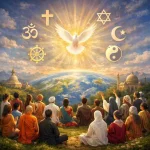‘Yoga’ : The Guru’s who contributed to the Yoga – Patanjali
Yoga is primarily a spiritiual discipline. Most people confuse yoga with the system of bodily postures. It is union with God or union of ego-self with the divine self, the infinite spirit. Bodily practice is called as Hatha Yoga while the true science of yoga is called Raja Yoga. If you want to keep yourself fit, Hatha Yoga is for you. If you to harmonize human consciousness with divine consciousness, then Raja Yoga is the one you should practice. This is not all, there is more to yoga. It is an art as well as science. It is a science, because it offers practical methods for controlling body and mind, thereby making deep meditation possible. It is an art, for unless it is practiced intuitively and sensitively it will yield only superficial results. Yoga is not a system of beliefs. It takes into account the influence on each other of body and mind, and brings them into mutual harmony. So often, for instance, the mind cannot concentrate simply because of tension or illness in the body, which prevent the energy from flowing to the brain. So often, too, the energy in the body is weakened because the will is dispirited, or paralyzed by harmful emotions. Yoga works primarily with the energy in the body, through the science of pranayama, or energy-control. Prana means also ‘breath.’ Yoga teaches how, through breath-control, to still the mind and attain higher states of awareness. Yoga is a very ancient science; it is thousands of years old. The perceptions derived from its practice form the backbone of the greatness of India, which for centuries has been legendary. The truths espoused in the yoga teachings, however, are not limited to India, nor to those who consciously practice yoga techniques. Many saints of other religions also, including many Christian saints, have discovered aspects of the spiritual path that are intrinsic to the teachings of yoga. Here we look at 10 different Yoga Gurus have brought about a kind of revolution in transferring the knowledge to their disciples: Patanjali – The Sage behind the Sutra The Science of Yoga is one of several unique contributions of India to the world. It seeks to discover and realize the ultimate Reality through yogic practices. One might have seen that all the guru’s and teachers, trainers quoting something or the other from ‘Yoga Sutra’, which is the guidebook of classical, or raja (royal), yoga calling it the authentic book on Yoga. Yoga Sutra was written at least 1,700 years ago by Patanjai, it’s made up of 195 aphorisms (sutras), or words of wisdom. Who Was The truth is that nobody really knows much—not even exactly when the sage lived. Some practitioners believe he lived around the second century BCE and also wrote significant works on Ayurveda (the ancient Indian system of medicine) and Sanskrit grammar, making him something of a Renaissance man. But based on their analyses of the language and the teaching of the sutras, modern scholars place Patanjali in the second or third century CE and ascribe the medical essays and grammar to various other “Patanjalis.” He was master of language – Sanskrit, mathematics and of astronomy. He is known as the father of modern yoga. He did not invent yoga as it is generally believed. Yoga was already there in various forms, which he assimilated into a system.  Legend There many versions as to who is Patanjali! One version states that all the Munis and Rishis approached Lord Vishnu to tell him that even though He (incarnated as Lord Dhanvanthari) had given them the means to cure illnesses through Ayurveda, people still fell ill. They also wanted to know what to do when people got sick. Sometimes it is not just physical illness, but mental and emotional illness too that needs to be dealt with. Anger, lust, greed, jealousy etc. How does one get rid of all these impurities? What is the formula? Vishnu was lying on the bed of snakes — the serpent Adishésha with 1,000 heads. When the Rishis approached Him, He gave them Adishésha (the symbol of awareness), who took birth in the world as Maharishi Patanjali. Another version relates that in order to teach yoga on earth, he fell from heaven in the form of a little snake, into the upturned plans (a gesture known as anjali) of his virgin mother, Gonika, herself a powerful yogini. Here he’s regarded as an incarnation of the thousand-headed serpent-king named Remainder (Shesha) or Endless (Ananta), whose coils are said to support the god Vishnu.
Legend There many versions as to who is Patanjali! One version states that all the Munis and Rishis approached Lord Vishnu to tell him that even though He (incarnated as Lord Dhanvanthari) had given them the means to cure illnesses through Ayurveda, people still fell ill. They also wanted to know what to do when people got sick. Sometimes it is not just physical illness, but mental and emotional illness too that needs to be dealt with. Anger, lust, greed, jealousy etc. How does one get rid of all these impurities? What is the formula? Vishnu was lying on the bed of snakes — the serpent Adishésha with 1,000 heads. When the Rishis approached Him, He gave them Adishésha (the symbol of awareness), who took birth in the world as Maharishi Patanjali. Another version relates that in order to teach yoga on earth, he fell from heaven in the form of a little snake, into the upturned plans (a gesture known as anjali) of his virgin mother, Gonika, herself a powerful yogini. Here he’s regarded as an incarnation of the thousand-headed serpent-king named Remainder (Shesha) or Endless (Ananta), whose coils are said to support the god Vishnu.  The Yoga Sutra Shiva, the Adiyogi or first yogi, transmitted yoga to the Sapta Rishis or the seven sages many thousands of years ago. He had the highest understanding of human nature, but he didn’t put anything down in writing. He was too wild to be a scholar. He found it was too difficult to put everything he knew into one person, so he chose seven people and put different aspects of yoga into them. These became the seven basic forms of yoga. Even today, though these have branched off into hundreds of systems, yoga has still maintained seven distinct forms. Sutra literally means a thread. Or in modern language, we can say it is a formula. Patanjali came much later and sort of assimilated everything. He saw that it was getting too diversified and complex for anyone to understand in any meaningful way. So he assimilated and included all aspects into a certain format – as the Yoga Sutras. Patanjali’s Yoga Sutras a book because it is not a book. It is a complex arrangement of tools. The Yoga Sūtras of Patañjali are 196 Indian sutras (aphorisms). The Yoga Sūtras of Patañjali was the most translated ancient Indian text in the medieval era, having been translated into about forty Indian languages and two non-Indian languages: Old Javanese and Arabic. According to Feuerstein, the Patanjali Yoga Sutras are a condensation of two different traditions, namely “eight limb yoga” (ashtanga yoga) and action yoga (Kriya yoga). Must read Yoga in USA – thousands gather to perform Yoga across the cities
The Yoga Sutra Shiva, the Adiyogi or first yogi, transmitted yoga to the Sapta Rishis or the seven sages many thousands of years ago. He had the highest understanding of human nature, but he didn’t put anything down in writing. He was too wild to be a scholar. He found it was too difficult to put everything he knew into one person, so he chose seven people and put different aspects of yoga into them. These became the seven basic forms of yoga. Even today, though these have branched off into hundreds of systems, yoga has still maintained seven distinct forms. Sutra literally means a thread. Or in modern language, we can say it is a formula. Patanjali came much later and sort of assimilated everything. He saw that it was getting too diversified and complex for anyone to understand in any meaningful way. So he assimilated and included all aspects into a certain format – as the Yoga Sutras. Patanjali’s Yoga Sutras a book because it is not a book. It is a complex arrangement of tools. The Yoga Sūtras of Patañjali are 196 Indian sutras (aphorisms). The Yoga Sūtras of Patañjali was the most translated ancient Indian text in the medieval era, having been translated into about forty Indian languages and two non-Indian languages: Old Javanese and Arabic. According to Feuerstein, the Patanjali Yoga Sutras are a condensation of two different traditions, namely “eight limb yoga” (ashtanga yoga) and action yoga (Kriya yoga). Must read Yoga in USA – thousands gather to perform Yoga across the cities










